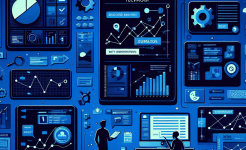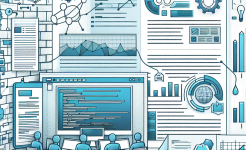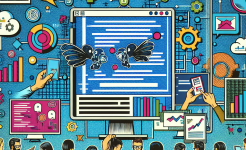Task Management Tools
Task management tools play a pivotal role in Agile stand-up meetings. They provide a centralized platform where team members can track their tasks, deadlines, and progress. One of the key advantages of these tools is that they offer real-time visibility into the work status of each team member. For example, tools like Jira and Trello allow users to create tasks, assign them to individuals, and update their progress with just a few clicks. This makes it easy for team members to quickly report on what they have completed since the last stand-up, what they plan to do next, and any obstacles they are facing.
Moreover, task management tools often come with features such as task dependencies and notifications. Task dependencies help team members understand how their work is interconnected with others, which is crucial for effective coordination. Notifications ensure that everyone is aware of important updates, such as when a task is completed or when a new task is assigned. This keeps the team informed and on top of their work, enhancing the overall efficiency of the stand-up meeting.
In addition, these tools can generate reports and analytics that provide valuable insights into the team's performance. For instance, managers can use these reports to identify bottlenecks, track the progress of projects, and measure the productivity of individual team members. This data-driven approach helps in making informed decisions and continuously improving the Agile process.
Visual Boards
Visual boards are another essential tool for Agile stand-up meetings. They offer a visual representation of the project's progress, making it easier for team members to understand the overall status at a glance. Tools like Kanban boards are widely used in Agile environments. A Kanban board typically consists of columns representing different stages of the work, such as "To Do," "In Progress," and "Done." Cards are used to represent individual tasks, and as the tasks move through the different stages, the cards are physically or digitally moved across the board.
Visual boards provide a clear and intuitive way for team members to communicate. During the stand-up meeting, team members can refer to the board to quickly report on the status of their tasks. For example, they can point to a card in the "In Progress" column and discuss any issues they are facing while working on that task. This visual aid helps in reducing misunderstandings and ensuring that everyone is on the same page.
Furthermore, visual boards promote transparency within the team. Everyone can see what tasks are being worked on, who is responsible for them, and how far along they are. This transparency fosters a sense of accountability among team members, as they know that their work is visible to the entire team. It also encourages collaboration, as team members can easily identify areas where they can offer support or assistance.
Communication Tools
Effective communication is the cornerstone of successful Agile stand-up meetings, and communication tools are essential for facilitating this. Tools like Slack and Microsoft Teams have become popular in Agile teams. These tools allow team members to communicate in real-time, both during and outside of the stand-up meeting. They offer features such as instant messaging, voice and video calls, and file sharing.
During the stand-up meeting, communication tools can be used to ensure that all team members can participate, regardless of their location. For example, if a team member is working remotely, they can join the meeting via a video call. This enables face-to-face interaction, which is important for building relationships and effective communication.
In addition, communication tools provide a platform for team members to continue discussions after the stand-up meeting. If a topic requires further exploration or if there are follow-up actions to be taken, team members can use the messaging feature to exchange ideas and coordinate. This helps in keeping the momentum going and ensures that important issues are not overlooked.
Moreover, these tools often integrate with other Agile tools, such as task management and visual boards. This integration allows for seamless flow of information between different tools, making it easier for team members to manage their work and communicate effectively.
Time-Tracking Tools
Time-tracking tools are valuable for Agile stand-up meetings as they help in managing the meeting time effectively. These tools ensure that the stand-up meeting stays within the allotted time, which is typically short, usually around 15 minutes. Tools like Toggl and Harvest allow users to set a timer for the meeting and track the time spent on each topic.

By using time-tracking tools, the meeting facilitator can keep the discussion focused and on track. They can ensure that each team member has an equal opportunity to speak and that no one dominates the conversation. If a team member starts to go off on a tangent or spends too much time on a particular topic, the facilitator can use the time-tracking tool to gently remind them to move on.
In addition, time-tracking tools can provide valuable data on how the team spends its time during the stand-up meeting. This data can be used to analyze the efficiency of the meeting and identify areas for improvement. For example, if it is found that a significant amount of time is being spent on discussing a particular type of issue, the team can explore ways to address that issue more effectively outside of the stand-up meeting.
Furthermore, time-tracking tools can also be used to track the time spent on individual tasks. This information can be useful for estimating future projects, understanding the productivity of team members, and identifying any time-consuming bottlenecks in the workflow.
Document Sharing Tools
Document sharing tools are essential for Agile stand-up meetings as they allow team members to share important information and resources. Tools like Google Drive and Dropbox provide a centralized platform where team members can store and access documents, such as project plans, user stories, and technical specifications.
During the stand-up meeting, if a team member needs to refer to a particular document, they can easily access it through the document sharing tool. This ensures that everyone has access to the same information, reducing the chances of miscommunication. For example, if a team member is discussing a task that requires specific technical details, they can quickly pull up the relevant document and share the information with the rest of the team.
In addition, document sharing tools allow for real-time collaboration. Multiple team members can edit a document simultaneously, which is useful for updating project plans or adding new user stories. This collaborative feature promotes knowledge sharing and ensures that the team's documentation is up-to-date and accurate.
Moreover, these tools offer version control, which is important for tracking changes made to documents over time. If there are any disputes or questions regarding a particular change, team members can easily refer to the version history to understand who made the change and why. This helps in maintaining the integrity of the team's documentation and ensuring that everyone is working with the correct information.
Feedback Tools
Feedback tools are crucial for continuous improvement in Agile stand-up meetings. These tools allow team members to provide feedback on the meeting process, the effectiveness of the tools used, and the overall performance of the team. Tools like SurveyMonkey and Google Forms can be used to create simple surveys that team members can fill out after each stand-up meeting.
The feedback collected through these tools can be used to identify areas where the stand-up meeting can be improved. For example, if team members consistently report that the meeting is too long or that the discussion is not focused, the team can take steps to address these issues. They can adjust the meeting format, set clearer ground rules, or allocate more time for specific topics.
In addition, feedback tools can be used to gather suggestions for new tools or techniques that can enhance the effectiveness of the stand-up meeting. Team members may have valuable insights based on their experiences, and by listening to their suggestions, the team can stay updated with the latest best practices in Agile project management.
Furthermore, providing feedback through these tools can also boost team morale and engagement. When team members feel that their opinions are valued and that their feedback is being taken into consideration, they are more likely to be actively involved in the stand-up meeting and contribute to the team's success.
In conclusion, the six tools discussed above - task management tools, visual boards, communication tools, time-tracking tools, document sharing tools, and feedback tools - are essential for making Agile stand-up meetings more effective. Each tool plays a unique role in facilitating communication, collaboration, and transparency within the team. By leveraging these tools, teams can ensure that their stand-up meetings are productive, focused, and contribute to the overall success of the project. It is important for teams to evaluate their specific needs and choose the tools that best suit their requirements. With the right combination of tools, Agile stand-up meetings can become a powerful platform for driving project progress and achieving business goals. As the Agile methodology continues to evolve, teams should also stay open to exploring new tools and techniques to further enhance the effectiveness of their stand-up meetings. This continuous improvement mindset will enable teams to adapt to changing circumstances and deliver high-quality products and services in a timely manner.
ARTICLE TITLE :6 essential tools recommended for Agile stand-up meetings ,AUTHOR :ITpmlib

















